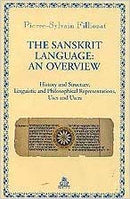Specification:
- Publisher : Indica Books
- By : Pierre-Sylvain Filliozat
- Cover : Paperback
- Edition : November 1, 2000
- Language : English
- Pages : 136
- Weight : 300 g.
- Size : 5.6 x 0.3 x 8.6 inches
- ISBN-10: 8186569170
- ISBN-13: 978-8186569177
- Product Code: BK14265
Description:
The Sanskrit Language by P.S. Filliozat has the rare distinction of being both an introductory book and a new ground-breaking study. It is an introductory book because the reader gets an accurate overview of the language, and it is also a new ground-breaking study because Filliozat’s approach harmonizes two different and complementary stands that often have been at war: the Western historical and comparative approach and the indigenous pandit tradition. Sanskrit is described here from these two points of view: what the native speakers knew and felt about their language, and what the foreign scholars did discover in their historical and comparative quest.
In the Indian branch of the Indo-European family of languages, Sanskrit is unique by its antiquity and stability. It has remained a living language over four milleniums. It owes its quality to the efforts of linguistic awareness of the first poets and the learned who used it in the practice of the Vedic religion. Right from the ancient times the grammarian Panini codified the procedures of formation of Sanskrit words. Some centuries later, his commentator Patanjali codified the procedures of interpretation of text. Sanskrit is properly the language generated and interpreted with such codes. The cultured Sanskrit user or pandit is one who has not only learnt the language, but also knows to use it and to analyse it with the same tools. Thus Sanskrit has always been a powerful instrument of culture and intellectual creation. It has been the learned language of pandits, a link language between the diverse regions of the entire Indian subcontinent, the medium of all scientific and technical knowledge, a language of religious teaching and practice. It has spread over the whole of Asia to the East of Iran.
About Author:
Prof. Pierre-Sylvain Filliozat teaches Sanskrit in Paris and conducts researches in several fields of Indology, Sanskrit grammar, poetry and poetics, history of Indian mathematics, Tantra, especially the Sanskrit Shaivagama literature, history of Indian architecture, etc. He has published books and articles in French, English and Sanskrit, on the Grammar of Panini, the Mahabhashya of Patanjali, Alamkarashastra, Sanskrit poetry, Shaivagama, temple architecture in Karnataka, etc.
Description
Specification:
- Publisher : Indica Books
- By : Pierre-Sylvain Filliozat
- Cover : Paperback
- Edition : November 1, 2000
- Language : English
- Pages : 136
- Weight : 300 g.
- Size : 5.6 x 0.3 x 8.6 inches
- ISBN-10: 8186569170
- ISBN-13: 978-8186569177
- Product Code: BK14265
Description:
The Sanskrit Language by P.S. Filliozat has the rare distinction of being both an introductory book and a new ground-breaking study. It is an introductory book because the reader gets an accurate overview of the language, and it is also a new ground-breaking study because Filliozat’s approach harmonizes two different and complementary stands that often have been at war: the Western historical and comparative approach and the indigenous pandit tradition. Sanskrit is described here from these two points of view: what the native speakers knew and felt about their language, and what the foreign scholars did discover in their historical and comparative quest.
In the Indian branch of the Indo-European family of languages, Sanskrit is unique by its antiquity and stability. It has remained a living language over four milleniums. It owes its quality to the efforts of linguistic awareness of the first poets and the learned who used it in the practice of the Vedic religion. Right from the ancient times the grammarian Panini codified the procedures of formation of Sanskrit words. Some centuries later, his commentator Patanjali codified the procedures of interpretation of text. Sanskrit is properly the language generated and interpreted with such codes. The cultured Sanskrit user or pandit is one who has not only learnt the language, but also knows to use it and to analyse it with the same tools. Thus Sanskrit has always been a powerful instrument of culture and intellectual creation. It has been the learned language of pandits, a link language between the diverse regions of the entire Indian subcontinent, the medium of all scientific and technical knowledge, a language of religious teaching and practice. It has spread over the whole of Asia to the East of Iran.
About Author:
Prof. Pierre-Sylvain Filliozat teaches Sanskrit in Paris and conducts researches in several fields of Indology, Sanskrit grammar, poetry and poetics, history of Indian mathematics, Tantra, especially the Sanskrit Shaivagama literature, history of Indian architecture, etc. He has published books and articles in French, English and Sanskrit, on the Grammar of Panini, the Mahabhashya of Patanjali, Alamkarashastra, Sanskrit poetry, Shaivagama, temple architecture in Karnataka, etc.
Payment & Security
Your payment information is processed securely. We do not store credit card details nor have access to your credit card information.


